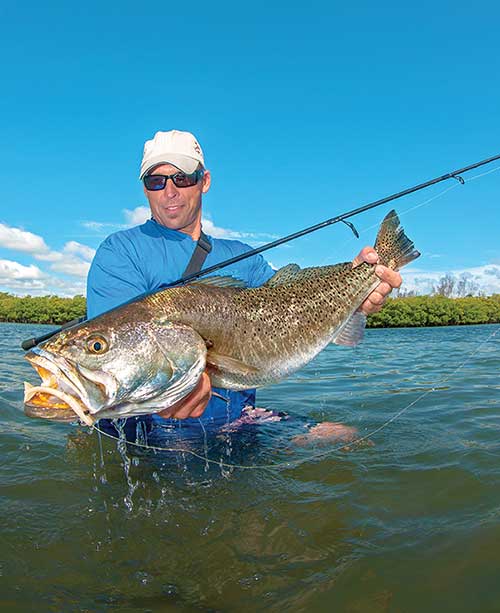
By Dustin Catrett:
A roseate spoonbill paid little attention as we crept along the mangroves less than a mile from where the ocean and river converged. The cool incoming tide pushed against my legs, as a definitive line of blue water slowly flowed into the Indian River Lagoon. Casting into the current, my buddy Ed and I slowly retrieved lures over a thick bed of seagrass.
“Fish on!” he shouted, as a scrappy blue-and-green striped fish wiggled on the end of his line. It wasn’t the snook he was expecting or a redfish like the one I’d caught earlier.
“Little mutton snapper,” he said, tossing it back. “You never know what you might catch around here.”
Moments later, my rod also curved into an arc.
“What’ve you got?” Ed asked.
“Snook!” I happily replied, catching a glimpse of its dark lateral line as it launched out of the water and into the air.
“We’ve got a double then,” he said, as his rod bowed for the second time. Only it wasn’t a snook, redfish or snapper at the end of his line; it was a huge spotted seatrout. Referred to as “gators,” for their large size, it was one of the largest seatrouts I’d ever seen. Ed and I stared in awe as the giant fish thrashed and churned saltwater just feet from Ed’s rod tip. I quickly landed my snook then released it, while Ed continued to battle the big fish for several minutes before managing to grab it with both hands.
“They don’t get much bigger than this,” he beamed proudly, lifting the massive fish up for a photo. We estimated the seatrout to be more than 30 inches long, and after admiring it for a few moments, Ed gently lowered it back into the water where it swam away.
Made For Anglers
Home to the current International Game Fish Association (IGFA) world record for the largest spotted seatrout caught (it weighed more than 17 pounds), the diverse crystal blue waters of Fort Pierce, in St. Lucie County, always deliver a spectacular fishing experience each time Ed and I visit. Spotted seatrout grows much larger here than in other parts of the country, a benefit of the region’s warm tropical climate and abundance of prey fish commuting through the Fort Pierce inlet from the Atlantic Ocean. There are also redfish, tarpon and all four types of snook, along with a smorgasbord of other varieties such as lookdown, flounder, bluefish, black drum, jack crevalle, sheepshead, pompano, snapper, and grouper to catch, as the lagoon is an estuary for many inshore and pelagic species alike.
For more than a hundred years, Fort Pierce in St. Lucie County has been a fishing town, and each year I’m pleasantly surprised to find that all the local hotels, tackle shops and restaurants still eagerly accommodate anglers like us. There are plenty of fishing piers, boat launches and public parks providing easy access to the water. Kayaking around areas like Little Jim Island and Bear Point, we’re always able to find a fish or two to catch. Seventeen miles (give or take a few miles) off the coast, the warm currents from the nearby Gulfstream provide plenty of bluewater action each winter when the “Sailfish Capital of the World,” just south of St. Lucie County, experiences huge migrations of Atlantic sailfish through its world famous “Sailfish Alley.”
All Around Alluring
Yesterday, Ed and I found several private inshore and offshore fishing charters in the area that cater to anyone’s budget and schedule. We ended up booking an offshore charter—aboard The Last Mango—and had a blast winching up grouper, snapper, and amberjack from the patchwork of reefs and wrecks along the ocean floor. That evening, we recounted fish tales over wine and dinner at Cobb’s Landing overlooking the Fort Pierce City Marina. The open-air, tiki-style restaurant cleaned, prepared and served our very own catch in a variety of delectable entrees. After a short stroll to the Sailfish Brewery for craft beers, it was back to our rooms to rest up for the following day.
This morning, Ed and I were eager to get to the lagoon to cast our lines. After putting on my waders, I quietly stepped into the calm serene water just after sunrise. As the ocean slowly drank the river, it reaffirmed to me why wade fishing during a falling tide is the real treasure of the area. Even without a boat or kayak, I can still immerse myself within one of the most diverse ecosystems on the planet, where dolphins, manatees, and birds of every color abound.
It’s one of few places where the next cast could be another world record or result in catching a species I’ve never seen before. And best of all, it’s knowing as soon as the sun illuminates the warm blue water, a few of life’s worries will wash away with the tide.
Get hooked on Fort Pierce in St. Lucie!